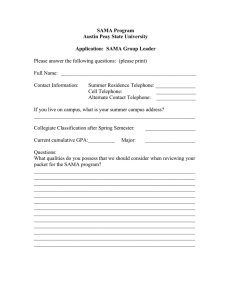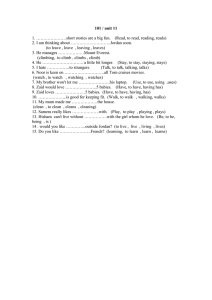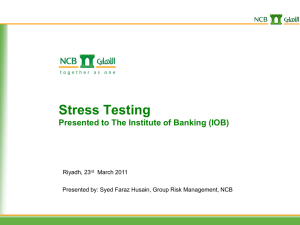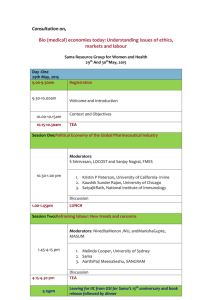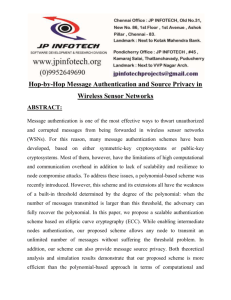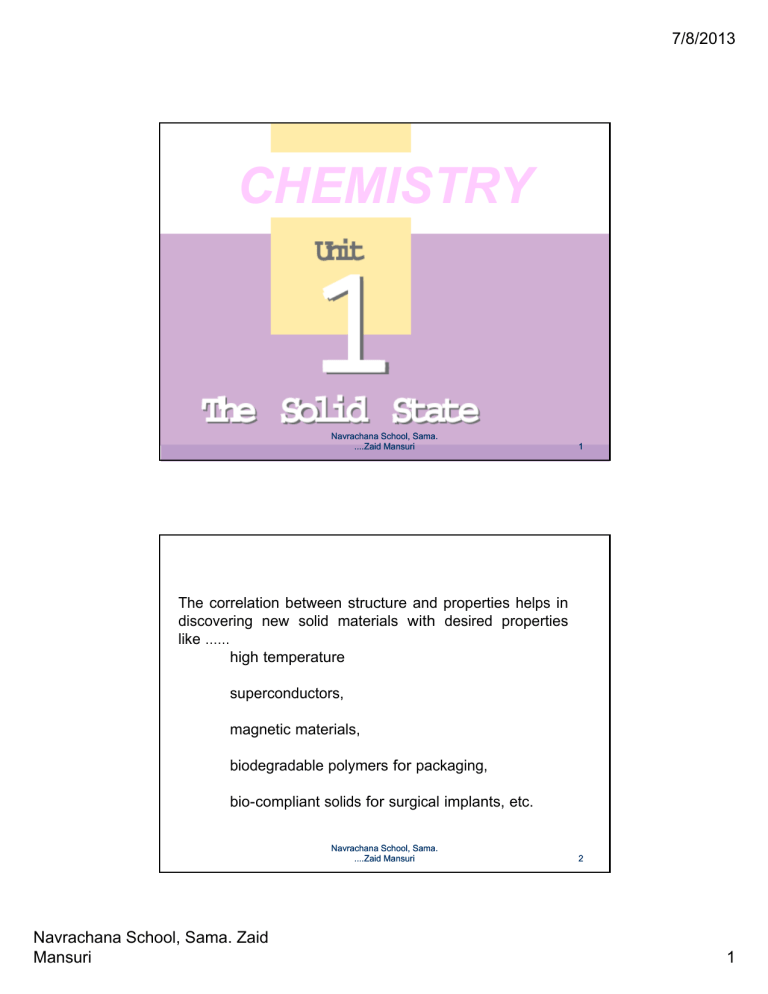
7/8/2013 CHEMISTRY Navrachana School, Sama. ....Zaid Mansuri 1 The correlation between structure and properties helps in discovering new solid materials with desired properties like …… high temperature superconductors, magnetic materials, biodegradable polymers for packaging, bio-compliant solids for surgical implants, etc. Navrachana School, Sama. ....Zaid Mansuri Navrachana School, Sama. Zaid Mansuri 2 1 7/8/2013 1 . 1 General Characteristics of Solid State (i) They have definite mass, volume and shape. (ii) Intermolecular distances are short. (iii) Intermolecular forces are strong. (iv) Their constituent particles (atoms, molecules or ions) have fixed positions and can only oscillate about their mean positions. (v) They are incompressible and rigid. Navrachana School, Sama. ....Zaid Mansuri 3 1.2 Amorphous and Crystalline Solids S o l i d s Crystalline Amorphous (Greek amorphous = no form) -long range order -short range order eg : Sodium chloride and quartz are typical examples eg : Glass, rubber and plastics are typical examples -sharp MP -range of MP The structure of amorphous solids is similar to that of liquids. On heating Amorphous crystalline at some temperature. Eg : Some glass objects from ancient civilizations are found to become milky in appearance because of some crystallization. Navrachana School, Sama. ....Zaid Mansuri Navrachana School, Sama. Zaid Mansuri 4 2 7/8/2013 Amorphous solids are also called as pseudo solids or super cooled liquids. b.coz they have tendency to flow like liquids. Window panes are thicker at bottom ! Crystalline solids are Anisotropic i.e. some of their physical properties like electrical resistance or refractive index show different values when measured along different directions in the same crystals. ( b’coz of different arrangement of particles in different directions) Amorphous solids are Isotropic Navrachana School, Sama. Zaid Mansuri Navrachana School, Sama. ....Zaid Mansuri 5 Navrachana School, Sama. ....Zaid Mansuri 6 3 7/8/2013 Suming up Navrachana School, Sama. ....Zaid Mansuri 7 1.3 Classification of Crystalline Solids On the basis of nature of intermolecular forces operating between them, solids are classified into 4 categories ….. Navrachana School, Sama. ....Zaid Mansuri 8 www.chemzblog.wordpress.com Navrachana School, Sama. Zaid Mansuri 4 7/8/2013 1.3 Classification of Crystalline Solids Navrachana School, Sama. ....Zaid Mansuri 9 Navrachana School, Sama. ....Zaid Mansuri 10 Metallic bond Navrachana School, Sama. Zaid Mansuri 5 7/8/2013 1.4 Crystal Lattices and Unit Cells characteristic Crystal lattice : A regular three dimensional arrangement of points in space is called a crystal lattice. There are only 14 possible three dimensional lattices. These are called Bravais Lattices Characteristics of a crystal lattice: (a) Each point in a lattice is called lattice point or lattice site. (b) Each point in a crystal lattice represents one constituent particle which may be an atom, a molecule (group of atoms) or an ion. (c) Lattice points are joined by straight lines to bring out the geometry of the lattice. Navrachana School, Sama. ....Zaid Mansuri 11 Unit cell : is the smallest portion of a crystal lattice which, when repeated in different directions, generates the entire lattice. Characteristics of a unit cell : (i) a, b and c - sides - may or may not be mutually perpendicular. perpendicular. (ii) a, ß & - angles Thus, a unit cell is characterized by six parameters, a, b, c, a, ß and . Navrachana School, Sama. ....Zaid Mansuri Navrachana School, Sama. Zaid Mansuri 12 6 7/8/2013 1.4.1 Primitive and Centered Unit Cells Unit cells Primitive Unit Cell Centred Unit Cells particles are present only on the corner positions. one or more constituent particles at positions other than corners in addition to those at corners, it is called a centered unit cell. (i) Body-Centred Unit Cells (bcc) (ii) Face-Centred Unit Cells (fcc) (iii) End-Centred Unit Cells Navrachana School, Sama. Zaid Mansuri Navrachana School, Sama. ....Zaid Mansuri 13 Navrachana School, Sama. ....Zaid Mansuri 14 7 7/8/2013 Navrachana School, Sama. Zaid Mansuri Navrachana School, Sama. ....Zaid Mansuri 15 Navrachana School, Sama. ....Zaid Mansuri 16 8 7/8/2013 Navrachana School, Sama. ....Zaid Mansuri 1.5 Number of Atoms in a Unit Cell 17 Shows contribution of each sphere 1.5.1 Primitive Cubic Unit Cell Only centre of sphere and not actual size Actu al size Navrachana School, Sama. ....Zaid Mansuri Navrachana School, Sama. Zaid Mansuri Corners 8 x 1/8 = 1 atom 18 9 7/8/2013 1.5.2 Body- Centered Cubic Unit Cell 8 corners × 1/8 1 at body centre = 1 atom + = 1 atom Total per unit cell = 2 atoms Navrachana School, Sama. ....Zaid Mansuri 19 1.5.3 Face- Centred Cubic Unit Cell 8 corners x 1/8 = 1 atom 6 at faces x 1/2 = 3 atoms Total per unit cell cell == 44 atoms atoms Navrachana School, Sama. ....Zaid Mansuri Navrachana School, Sama. Zaid Mansuri 20 10 7/8/2013 1.6 Close Packed Structures Coordination number : is the number of nearest neighbors of a particle. (a) Close Packing in 1D C.N. = 2 (b) Close Packing in 2D C.N. = 4 C.N. = 6 Navrachana School, Sama. ....Zaid Mansuri 21 (c) Close Packing in 3D (i) Square close-packed in 3D AAAAAA… Navrachana School, Sama. ....Zaid Mansuri Navrachana School, Sama. Zaid Mansuri 22 11 7/8/2013 (ii) hexagonal close packing in 3D (a) Placing second layer (B) over the first layer (a) Navrachana School, Sama. ....Zaid Mansuri 23 Voids are formed… For N spheres in closed packed spheres there are N octahedral voids & Navrachana School, Sama. 2N tetrahedral voids ....Zaid Mansuri Navrachana School, Sama. Zaid Mansuri 24 12 7/8/2013 (b) Placing third layer over the second layer Covering Tetrahedral Voids: ABABAB…. (hcp) Covering Octahedral Voids: ABCABCABC….(ccp or fcc) Navrachana School, Sama. ....Zaid Mansuri Covering octahedral voids ABCABC… ccp Covering tetrahedral voids ABAB… hcp Navrachana School, Sama. ....Zaid Mansuri Navrachana School, Sama. Zaid Mansuri 25 26 13 7/8/2013 1.6.1 Formula of a Compound and Number of Voids Filled Tetrahedral voids in ccp / fcc Total no. of tetrahedral voids = 1 x 8 = 8 Navrachana School, Sama. ....Zaid Mansuri 27 Octahedral voids in ccp / fcc at edge centre : at body centre : ¼ x 12 = 3 1x1=1 Navrachanavoids School, Sama. = Total no. of octahedral ....Zaid Mansuri Navrachana School, Sama. Zaid Mansuri 4 28 14 7/8/2013 Summing up …. Formula of fcc/ccp If in fcc or ccp, atoms A occupy all octahedral voids and B occupy the Lattice points points ,, the the unit unit cell cell contains contains 4 A and 4 A i.e. the formula of the crystal is AB If in fcc or ccp A occupy all tetrahedral voids and B occupy the Lattice points , the unit cell contains 8 A and 4 B i.e. the formula of the crystal is A 2B Navrachana School, Sama. ....Zaid Mansuri 29 Example 1.1 A compound is formed by two elements X and Y. Atoms of the element Y (as anions) make ccp and those of the element X (as cations) occupy all the octahedral voids. What is the formula of the compound? Ans : XY Example 1.2 Atoms of element B form hcp lattice and those of the element A occupy 2/3rd of tetrahedral voids. What is the formula of the compound formed by the elements A and B? Ans : A4B3 Navrachana School, Sama. ....Zaid Mansuri Navrachana School, Sama. Zaid Mansuri 30 15 7/8/2013 1.7 Packing Efficiency What is packing efficiency? Packing efficiency is the percentage of total space filled by the particles. So, If total vol. of the unit cell 100% Vol. occupied by the spheres in the unit cell ? (packing efficiency) Packing efficiency = vol. occupied by the spheres in the unit cell total vol. of the unit cell x 100 % Navrachana School, Sama. ....Zaid Mansuri 31 1.7 Packing Efficiency 1.7.1 Packing Efficiency in hcp and ccp Structures 74% Packing efficiency = vol. occupied by 4 spheres in the unit cell x 100 % total vol. of the unit cell Navrachana School, Sama. ....Zaid Mansuri Navrachana School, Sama. Zaid Mansuri 32 16 7/8/2013 1.7.2 Efficiency of Packing in bcc 68% Structures Packing efficiency = vol. occupied by 2 spheres in the unit cell x 100 % total vol. of the unit cell Navrachana School, Sama. ....Zaid Mansuri 33 1.7.3 Packing Efficiency in Simple simple cubic 52.4 % Packing efficiency = vol. occupied by 1 sphere in the unit cell x 100 % total vol. of the unit cell Navrachana School, Sama. ....Zaid Mansuri Navrachana School, Sama. Zaid Mansuri 34 17 7/8/2013 1.8 Calculations Involving Unit Cell Dimensions Density of the unit cell, d = mass of the unit cell volume of the unit cell (v) = z.m a3 d= z. M a3 NA , z = no. of atoms in unit cell a = edge length of unit cell m = mass of an atom in unit cell ( b’coz, m = M / NA ) Navrachana School, Sama. ....Zaid Mansuri Example 1.3 35 An element has a body-centred cubic (bcc) structure with a cell edge of 288 pm. The density of the element is 7.2 g/cm3. How many atoms are present in 208 g of the element? Navrachana School, Sama. ....Zaid Mansuri Navrachana School, Sama. Zaid Mansuri 36 18 7/8/2013 1.9 Imperfections in Solids • Crystals though have long range order ---- are not perfect • Solids consists aggregate of large no. of small crystals. • crystals have defects ---when crystallization takes place at moderate or fast rate • even at extremely slow rate ---- crystals are not free from defects (imperfections) Crystal defects : are basically irregularities in the arrangement of constituent particles. Line defects : are the irregularities or deviation from ideal arrangement in entire row Point defects : are the irregularities or deviation from ideal arrangement around a point or an atom Navrachana School, Sama. ....Zaid Mansuri 37 Crystal defects Line defects Point defects Stoichiometric defects These are the point defects that do not disturb the stoichiometry of the solid. They are also called intrinsic or thermodynamic defects. Impurity defects Metal excess defects Non-Stiochiometic defects Metal deficient defects Due to anionic vacancies 1. Vacancy defects 2. Interstitial defects Due to extra cations in the interstital 3. Frenkel defects 4. Schottky defects Navrachana School, Sama. ....Zaid Mansuri Navrachana School, Sama. Zaid Mansuri 38 19 7/8/2013 1. Vacancy defects When some of the lattice sites are vacant, the crystal is said to have vacancy defect (Fig. 1.23). - density of the substance decreases. -This defect can also develop when a substance is heated. - Shown by non-ionic solids Navrachana School, Sama. ....Zaid Mansuri 2. Interstitial defects When some constituent particles (atoms or molecules) occupy an interstitial site, the crystal is said to have interstitial defect. -density of the substance increases - shown by non-ionic solids Navrachana School, Sama. ....Zaid Mansuri Navrachana School, Sama. Zaid Mansuri 39 40 20 7/8/2013 Note : Ionic solids must always maintain electrical neutrality. Rather than simple vacancy or interstitial defects, they show these defects as Frenkel and Schottky defects. 3. Frenkel defects When the smaller ion (usually cation) is dislocated from its normal site to an interstitial site it is called Frenkel defect. - It creates a vacancy defect at its original site and an interstitial defect at its new location. - Frenkel defect is also called dislocation defect. - density of the solid does not change. - shown by ionic substance in which there is a large difference in the size of ions, - for example, ZnS, AgCl, AgBr and AgI due to Vacancy Interstitial Navrachana School, Sama. ....Zaid Mansuri 4. Schottky defects 41 In this defect equal number of cations and anions are missing from their positions. - basically a vacancy defect. - Electrical neutrality is maintained. - density of crystal decreases - Eg : in NaCl there are approximately 106 Schottky pairs per cm3 at room temperature. In 1 cm3 there are about 1022 ions. Thus, there is one Schottky defect per 1016 ions. - shown by ionic substances in which the cation and anion are of almost similar sizes. - Eg : NaCl, KCl, CsCl and AgBr. - Note : AgBr shows both, Frenkel as well as Schottky defects. Vacancy Vacancy Navrachana School, Sama. ....Zaid Mansuri Navrachana School, Sama. Zaid Mansuri 42 21 7/8/2013 Impurity defects When some foreign impurities replace the ions of the crystal, the crystal is said to have Impurity defect. - e.g : SrCl2 in NaCl. Each Sr+2 replaces two Na+ ions to maintain the stoichiometry. One site is occupied while other remains vacant (cationic vacancy). hence equal no. of cationic vacancies are generated in this case. - e.g : CdCl2 + AgCl solid solution Foreign ion Vacancy Navrachana School, Sama. ....Zaid Mansuri 43 Metal excess defects Due to anionic vacancies e.g : NaCl & KCl When, NaCl(crystal) ----- Na(vapours) - NaCl - LiCl - KCl F-Centers yellow pink violet ( or liliac) F-centre Navrachana School, Sama. ....Zaid Mansuri Navrachana School, Sama. Zaid Mansuri 44 22 7/8/2013 Metal excess defects Due to extra cations in the interstital ZnO White --- Zn+2 + ½ O2 + 2eyellow - O is lost as O2 reversibly. - excess of Zn+2 occupies the interstitial nearby. - thus, Zn1+xO Metal deficient defects Many solids – difficult to prepare in stoichiometric composition - More anions than metals - Fe0.93O to Fe0.96O - some Fe+2 Fe+3 + e- to maintain the electrical neutrality of the crystal Navrachana School, Sama. ....Zaid Mansuri 45 1.10 Electrical properties Solids 10-20 - 107 ohm-1m-1 Conductors 104 - 107 ohm-1m-1 Semi-conductors 10-6 -104 ohm-1m-1 Insulators 10-20 -10-10 ohm-1m-1 good Navrachana School, Sama. ....Zaid Mansuri Navrachana School, Sama. Zaid Mansuri 46 23 7/8/2013 Band : the atomic orbitals of metal atoms form molecular orbitals which are so close in energy to each other as to form a band. Conduction band Valence band Conduction band : lowest unoccupied band Valence band : highest occupied Navrachana School, Sama. ....Zaid Mansuri Conductors 47 Insulators Semi-conductors Conductivity decreases Conductivity increases with rise in temperature with rise in temperature Eg : Si & Ge - Also called Intrinsic semi conductors - Cond. can can be be increased increased by adding suitable Impurities ( Doping) Electronic defects Electron deficient impurities Electron rich impurities Si (gr.14) doped with P or As (gr.15) Si (gr.14) doped with B Al or Ga (gr.13) Navrachana School, Sama. ....Zaid Mansuri Navrachana School, Sama. Zaid Mansuri 48 24 7/8/2013 Applications of n-type and p-type semi conductors : • diode p-type and n-type semiconductors & is used as a rectifier • transistors npn & pnp amplify radio or audio signals. • photo-diode solar cells • Combination of different group atoms to give average of 4e-s gr. 12 + gr. 16 e.g: ZnS, CdS, CdSe and HgTe gr. 13 + gr. 15 e.g: InSb, AlPb and GaAs have very fast response • In these compounds, the bonds are not perfectly covalent and the ionic character depends on the electronegativities of the two elements. • interesting ! transition metal oxides (TiO, CrO2 and ReO3) behave like metals!! ReO3 is like metallic copper in its conductivity and appearance. VO, VO2, VO3 and TiO3 show metallic or insulating properties depending on temperature. Navrachana School, Sama. ....Zaid Mansuri 49 1.11 Magnetic properties Every substance magnetic properties due to e-s behave like tiny magnets Magnetic moment Spin motion Orbital motion • Electron being a charged particle and undergoing these motions can be considered as a small loop of current which possesses a magnetic moment. • Each electron has a permanent spin and an magnetic moment Navrachana School, Sama. ....Zaid Mansuri Navrachana School, Sama. Zaid Mansuri Bohr magneton, 2 µB = 9.27 × 10–24A m 50 . 25 7/8/2013 1. Paramagnetism : due to presence of unpaired electrons weakly attracted by the magnetic field magnetized in a magnetic field in the same direction lose magnetism in the absence of mag. field e.g : O2, Cu2+, Fe3+, Cr3+ Navrachana School, Sama. ....Zaid Mansuri 51 Diamagnetism: • weakly repelled by a magnetic field. • eg: H2O, NaCl and C6H6 • They are weakly magnetised in a magnetic field in opposite direction. • shown by those substances in which all the electrons are paired and there are no unpaired electrons. • Pairing of electrons cancels their magnetic moments and they lose their magnetic character. Navrachana School, Sama. ....Zaid Mansuri Navrachana School, Sama. Zaid Mansuri 52 26 7/8/2013 Ferromagnetism: • A few substances like iron, cobalt, nickel, gadolinium and CrO2 are attracted very strongly by a magnetic field. Such substances are called ferromagnetic substances. • can be permanently magnetised. • In solid state, the metal ions of ferromagnetic substances are grouped together into small regions called domains. Thus, each domain acts as a tiny magnet. • In an unmagnetised piece of a ferromagnetic substance the domains are randomly oriented and their magnetic moments get cancelled. When the substance is placed in a magnetic field all the domains get oriented in the direction of the magnetic field and a strong magnetic effect is produced. This ordering of domains persist even when the magnetic field is removed and the ferromagnetic substance becomes a permanent magnet. Navrachana School, Sama. ....Zaid Mansuri 53 Antiferromagnetism: • Substances like MnO showing antiferromagnetism have domain structure similar to ferromagnetic substance, but their domains are oppositely oriented and cancel out each other's magnetic moment Navrachana School, Sama. ....Zaid Mansuri Navrachana School, Sama. Zaid Mansuri 54 27 7/8/2013 Ferrimagnetism: • the magnetic moments of the domains in the substance are aligned in parallel and antiparallel directions in unequal numbers. • weakly attracted by magnetic field as compared to ferromagnetic substances. • Examples: Fe3O4 (magnetite) and ferrites like MgFe2O4 and ZnFe2O4 are examples of such substances. • These substances also lose ferrimagnetism on heating and become paramagnetic. End of chapter Navrachana School, Sama. ....Zaid Mansuri Navrachana School, Sama. Zaid Mansuri 55 28 This document was created with Win2PDF available at http://www.win2pdf.com. The unregistered version of Win2PDF is for evaluation or non-commercial use only. This page will not be added after purchasing Win2PDF.

